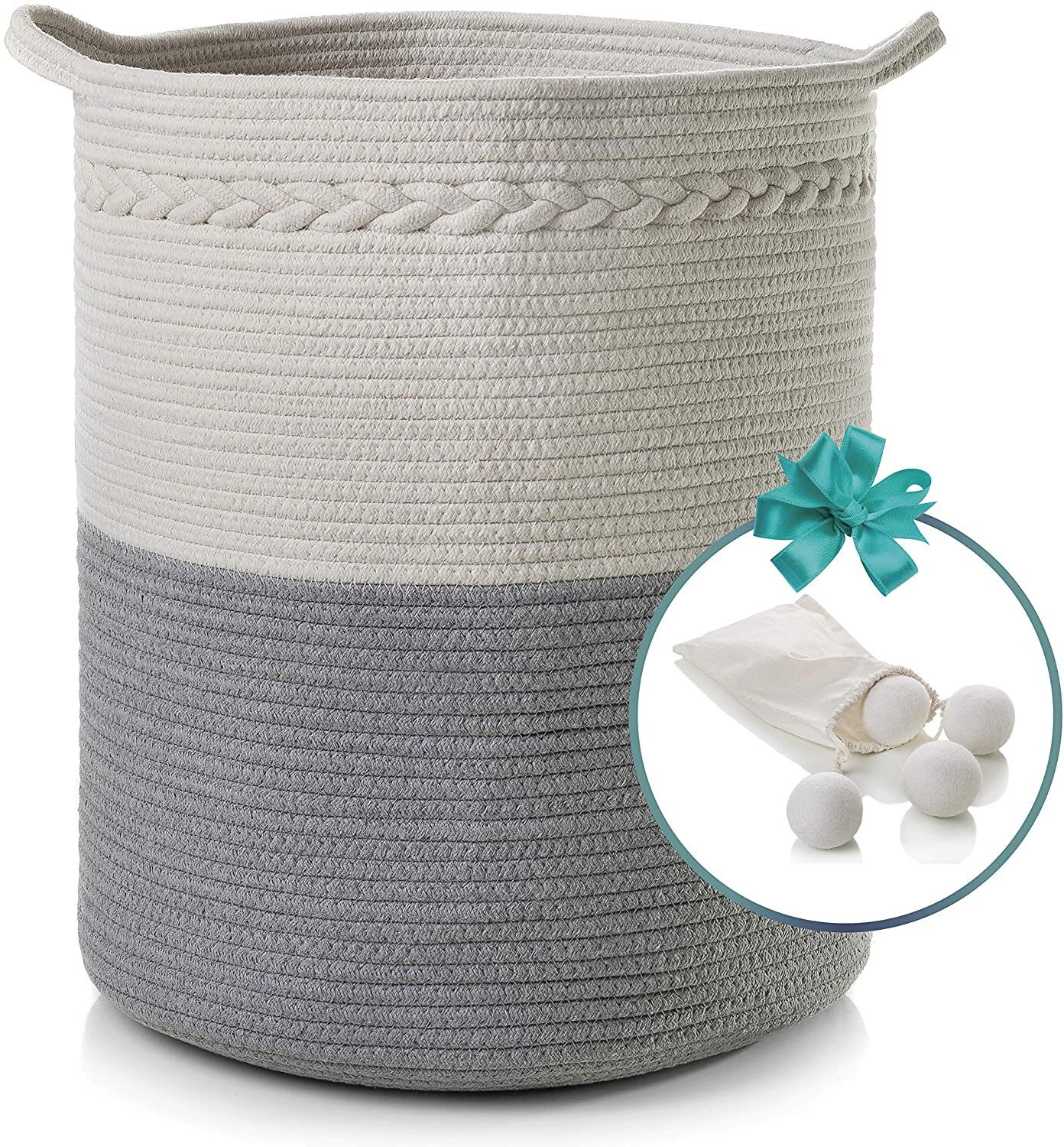Is it possible to have a large dog in an apartment?
Featuring: The best products for large dogs in an apartment.
As I am writing this, my nearly 55 pound dog is kicking me off of the couch with his outstretched back legs. He’s a long guy who can take up as much or as little space as he likes. He is either stretched out on the entire width of the queen-sized bed or curled up into a one-foot-diameter donut; there is no in between.
He is no Great Dane, but he has become bigger since we adopted him — teetering over the medium category into a large sized dog category. He is an American Foxhound and Treeing Walker Coonhound mix, two breeds that can reach up to 70 or 80 pounds. Although he is smaller than he was supposed to be, one thing is for certain: he is not a dog that is 25 pounds or under.
When my partner and I were looking for our first apartment together, we went in knowing that we would be adopting a dog shortly after moving in. We live in New York City, notorious for its shoebox apartments. Our requirements would be considered very general in any other location than NYC: two bedroom and dog-friendly. However, even with our Zillow filters turned on, it felt like every single apartment listing that claimed to be “pet friendly” only allowed cats or dogs under 25 pounds. We knew it wasn’t likely that we would be getting a small dog.
We got lucky and the second apartment we viewed was the perfect one: a small two bedroom in the heart of Astoria where the second bedroom was better suited as a home office/bedroom for a dog. The pet requirements were vague enough that we would be able to manage a bigger dog. “Well… they would prefer a smaller dog but… there’s not really any specifications,” the broker told us. Good enough, and we decided we would become spectacular tenants so the property manager would let it slide. If our property manager is reading this… I’m sorry for taking advantage of that.
Jonathan was 43 pounds when we adopted him — nearly skin and bones after surviving a hurricane abandoned in the Florida panhandle. He was a skinny little guy who quickly began to take up a lot of space in the apartment: extra large (albeit bigger than needed) crate, a giant food container to fit a bag of kibble to sustain for a month, drawers of treats, and a LOT (and I mean a lot) of toys. Frankly, figuring out where to keep all this stuff was a bigger problem than having enough space for the dog himself (see my recommendations for big-dog apartment at the end of this blog).
We carefully arranged our furniture and rearranged to make space for his things. With my partner being the analytical person he is, and myself being the visual learner I am, we made a to-scale fake model of each room on the computer so we could virtually place our dressers, tables, bed, and find a place to put Jonathan’s giant crate. We were totally determined to make it work, even willing to sacrifice our own belongings so the dog had room for his. I reiterate: figuring out where to keep our large dog’s things was harder than maintaining the large dog himself.
There is a huge misconception that size = energy level. I often get asked “how do have a dog that big in an apartment? He doesn’t have space to run around!” I can’t help but chuckle at this trite remark because, surprise, dogs aren’t doing their exercise indoors. I understand part of this worried sentiment because an apartment usually means we don’t have a fenced in yard. I like to say the city is our outdoor space. We live within walking distance of three different parks. Our neighborhood is perfect for long walks and there are plenty of opportunities for rule-abiding and supervised off leash time.
Funny enough, although we adopted Jonathan fully anticipating his breeds’ exercise needs and energy level, this large dog doesn’t have much energy. He spends his day rotating between the couch, his crate, and the bed taking naps. His breed group is known for being more high energy, often requiring space where they can chase small critters and bay to their hearts’ desires. It’s an anomaly that he prefers sleeping next to the radiator all day. With that being said, it is still vital to consider the potential energy level of the dog you are getting — whether it’s breed’s general temperament or what information the shelter/rescue has on the dog’s behavior. If an individual dog is going to go crazy in a small space without a yard (such as a high-energy, herding Australian Shepherd or Border Collie) or you are not able to sustain giving them their exercise needs, consider a different dog or a different living situation. It is important to think logically about dog ownership and prepare for the outcome of a dog’s needs. It is a living thing that has needs just like humans.
It is definitely tough to even consider adopting a large dog when many apartments don’t allow over 25lbs. There are plenty of large dogs available for adoption that immediately get looked over solely because of the building rules. Many argue that small dogs cause more damage due to the fact that how small dog owners are less likely to train the dog not to bark (something that big dog owners would definitely get into more trouble for over noise complaints), or will opt for nasty pee pads over taking it outside regularly (something big dogs can’t get away with either). On the other hand, I can understand why landlords opt for this, or no pets at all. Unfortunately many pet owners are irresponsible. They won’t train their dog or exercise them enough, leading to destruction in the apartment or constant barking. Landlords are probably sick of giving tenants the benefit of the doubt and decided to just enact a rule to prevent it from happening again. Unfortunately, larger dogs can be a larger liability when it comes to insurance. A lot of this can lie in misconception, I know, but the landlords have to cover themselves just in case. It is definitely a shame, but a rule that tenants will often have to abide.
A friend of ours with a giant rescue Catahoula mix, sent a “resume” for her dog to a potential new landlord that had a “case by case basis” for pets. The dog, a very sweet boy, admittedly looks a bit intimidating at first glance. This was when the resume came into play with what photos simply couldn’t explain. She included the dog’s walk schedule, his favorite activities, and their entire training history. They had put in months of professional training and were maintaining the practice even after the trainer left. Besides the fact that she was wiling to write this whole resume about the dog in the first place, the content itself showed how dedicated she and her boyfriend were as dog owners. A tenant that let their dog do whatever it wanted certainly wouldn’t be able to speak to all of this training and attention. Needless to say, they got the apartment, which is a beautiful space with a small yard to continue all of the good boy’s daily training activities.
The short answer to “is it possible to have a large dog in an apartment” is… yes. Yes, as long as you aren’t breaking rules and willing to put in the work. Yes, as long as you’re giving the dog what it needs and then some. However, this applies to any size dog. Even if your dog is 3 pounds soaking wet, you still need to be giving him or her the exercise, training, and attention they may need so they don’t destroy your furniture. Regardless of a dog’s breed, size, or age, it is safe to say that having a dog takes a lot of work. Although Jonathan was born a wild country boy, lots of training, structure, and patience allowed him to adapt swimmingly into the best city apartment dog I could ask for — even though his long legs push me off the bed in the middle of the night.
The best products for large dogs in an apartment.
Because Jonathan is crate trained, we have the Petmate double door crate. Having the double door gave us more options on figuring out where to keep it in our apartment, whether we used the short end door or the long end. Even better, it also easily folds up for storage under a bed. We have not needed to put it away yet because the boy loves his crate!
A 50+lb dog requires a lot of food. We opted for this skinny, movable airtight container that fits perfectly nestled between the wall and our kitchen cart, mostly out of sight until needed. Plus it is a great surface to put all of your dog’s Instagram friends’ stickers on.
3. Any Nina Ottosson Outward Hound Dog Puzzles
Although Jonathan does not personally require a lot of physical exercise, he definitely needs mental exercise. Our all time favorite toys to keep him busy are the Nina Ottosson Outward Hound puzzles. There are a dozen varieties and skill levels, and we have multiple! Just a few rounds with some training treats and his noggin gets worn out, resulting in a long nap. Also serves as a great slow-feeder!
4. Bone Dry Toy Storage Containers
We have multiple of these Bone Dry toy storage bins, which we usually keep out in the living room because Jonathan loves to “pick out” toys throughout the day. They fit well into corners and in between shelves to keep things tidy.
Alternatively, this super cute (washable) rope basket serves as a way to store dog toys and blankets while fitting your interior decor.
6. Door bells
Because we do not have a door that leads directly to a backyard, it was important for us to figure out Jonathan’s pee schedule. We trained him to ring this bell hanging on our doorknob when he wanted to go outside (it didn’t take any time because he quickly learned that when the bell rings, the door to freedom opens). This was a lifesaver for pinpointing the times he needed to be outside since we don’t have the luxury of letting him out whenever he wants.
7. A washable rug
Big dogs = big messes. I am so thankful we put forth the investment in a Ruggable rug. There have been plenty of accidents that were easily cleaned up because of this washable rug.












